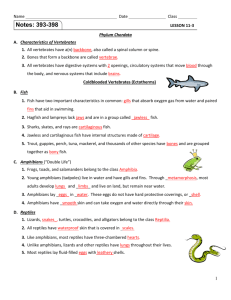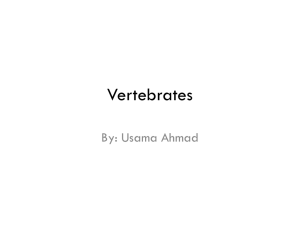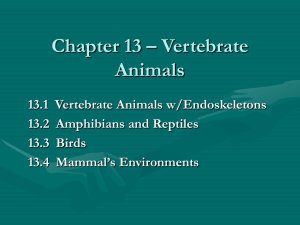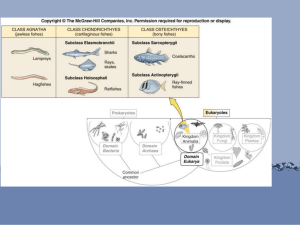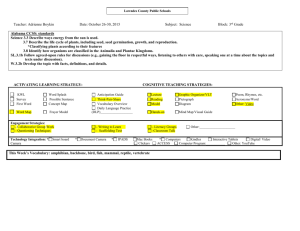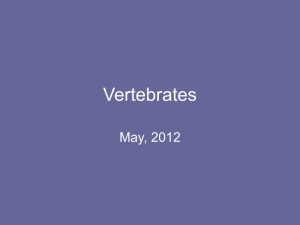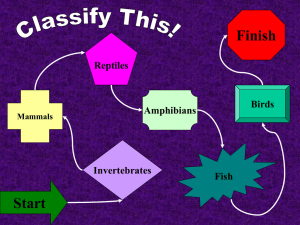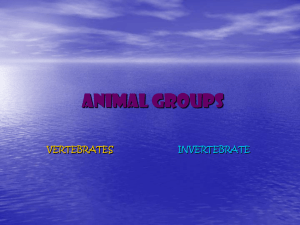chapter 15 fish, amphibians, and reptiles
advertisement
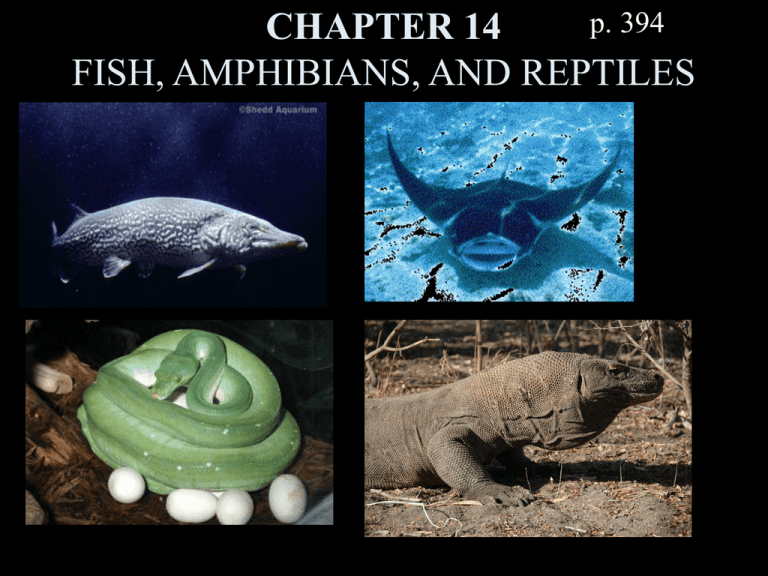
p. 394 CHAPTER 14 FISH, AMPHIBIANS, AND REPTILES All are vertebrates and belong to the Phylum Chordata “chordates” To be a chordate, certain characteristics must be present at sometime during its life. 1) Notochord (p.395) - a rod-like piece of cartilage that runs along the dorsal side. - it is present in humans during early development. - it turns into the backbone. - some have a notochord their entire life. (not vertebrates). Example 1: tunicate Example 2: lancelet 2) nerve chord - turns into the spinal cord. - carries messages from the brain. 3) gill slits (pharanygeal pouches) - openings in the throat area. - found in all vertebrates during the embryo stage. - turns into lungs. All vertebrates have an endoskeleton. Most vertebrates are ectotherms. - “cold-blooded” - their temperature changes with the environment. Endotherms maintain a constant temperature. - “warm-blooded” FISH - 30,000 different species. - three classes. 1) Class Agnatha “jawless fish” - simplest vertebrates. p. 402 - no jaw - has a ‘sucker’ mouth. - it sucks the fluids out of its host. -their skeletons are made of cartilage - no real bones - very flexible. Ex. Lampreys - attack healthy fish. - live in the Great Lakes (invasive species). Ex. Hagfish (p. 402) - attacks dying or dead fish. 2) Class Chondrichthyes (p. 402) - are the cartilaginous fish. Ex. sharks, rays, skates. - have skeletons made of cartilage. They have traits of ‘advanced’ fish. - scales - sharp and pointy. - not round. - ‘hydrodynamic’ - jaws - can ‘unhinge’. Sharks - most are not dangerous but are efficient predators. - replaceable teeth that slant inwards. - sense of smell Largest = Whale shark (45 feet long) ‘Meanest’ = Great White - sharks can reproduce sexually in three different ways. 1) young are born ‘live’. 2) lays eggs 3) eggs ‘hatch’ inside the female. More sharks… Thresher Shark Basking Shark Goblin Shark Sawtooth Shark More Cartilage Fish Manta Ray Skate North Dakota Chondrichthyes Paddlefish Sturgeon 3) Class Osteichthyes - largest class of fish. (95%) Three groups: 1) lung fish - have simple lungs and gills. ex. African lungfish “bony fish” 2) lobe-finned - fins attach to the skeleton. Ex. coelacanth 3) ray-finned - paired fins with long bony spines. - largest group. Ex. walleye, perch, salmon. ASSIGNMENT: WORKSHEET ‘FISH’ Features of a Bony Fish lateral line - runs along the side of the fish. - can sense vibrations and electrical currents. gills - water passes over the gills and they extract oxygen. - release CO2 - many tiny blood vessels. operculum - a bony plate which covers the gills. swim bladder - controls buoyancy. - fills with air to rise. - no eyelids! - two chambered heart. - reproduces sexually. - nostrils - a strong sense of smell. - have a complete digestive system. - stomach, liver, intestines… WHICH CLASS OF FISH? Manta Class Chondrichthyes Lamprey Class Agnatha Northern Class Osteichthyes READ “Origins of Fish” p. 406 ASSIGNMENT WORKSHEET: “GO FISH” Class Amphibia “Amphibians” p. 407 Ex. frogs, toads 2,500 different species. Amphibians must live near water. - keep skin moist. - to reproduce (lay eggs) Many amphibians in Minnesota have been found with deformities in recent years. - linked to the use of pesticides. - can easily be absorbed thru their skin. Amphibians are ectothermic. - during winter months they become inactive - slowed metabolism. - called hibernation. - some become inactive when temperatures are too hot or when water is scarce. - bury themselves underground. - called estivation. Amphibians need a strong endoskeleton to support their body while on land. - they have a three chambered heart. Frogs (p. 409) - have lungs but can stay under for long periods of time. - can absorb oxygen through their skin. - have hinged joints - reproduce sexually - lay eggs in water. Hundreds of different species and sizes - colors are often “bright” -poisonous Toads - can spend more time out of the water. - skin is ‘bumpier’ - doesn’t dry out. - but must return to water to reproduce. Salamanders - often confused with lizards. - smooth skin (no scales). - amphib with a tail. Caecilians - a legless, blind amphibian found in rain forests AMPHIBIAN METAMORPHOSIS p. 412 - the change in form from egg to adult. egg tadpole - have gills - must stay in water. - develops legs. - tail is absorbed. - begins eating insects - protein speeds up the process. adult Usually takes 4 - 6 weeks. - warm water and plenty of food will increase the speed of metamorphosis. - but can take years… ASSIGNMENT WORKSHEET: ‘AMPHIBIANS’ Class Reptilia ‘Reptiles’ p. 412 Ex. turtle, snakes, alligator. - they do not have to return to water. 1) scales - keep moisture in. 2) hard shell - amniotic egg - more durable. All* reptiles have claws. Reptiles have a three chambered heart. - provides more oxygen to the body. - have lungs - are land organisms. READ ‘Importance and Origin of Reptiles’ (p. 417). Lizards - most are small. - but the Komodo Dragon can be 10 feet long. - most lizards are harmless. - many eat insects. - some are venomous. More lizards… Gila Monster Fringed Lizard Gecko Zebra Lizard Alligators Snakes - reptiles without legs. - can unhinge their jaw. - to swallow large prey. - some are venomous. Rattlesnake Coral Snake Some reptiles have shown maternal care. - the mother protects the eggs and the young after they hatch. Reptiles are more advanced and survivable than amphibians. - water is the greatest limiting factor. ASSIGNMENT: WORKSHEET ‘ECTOTHERM REVIEW’
